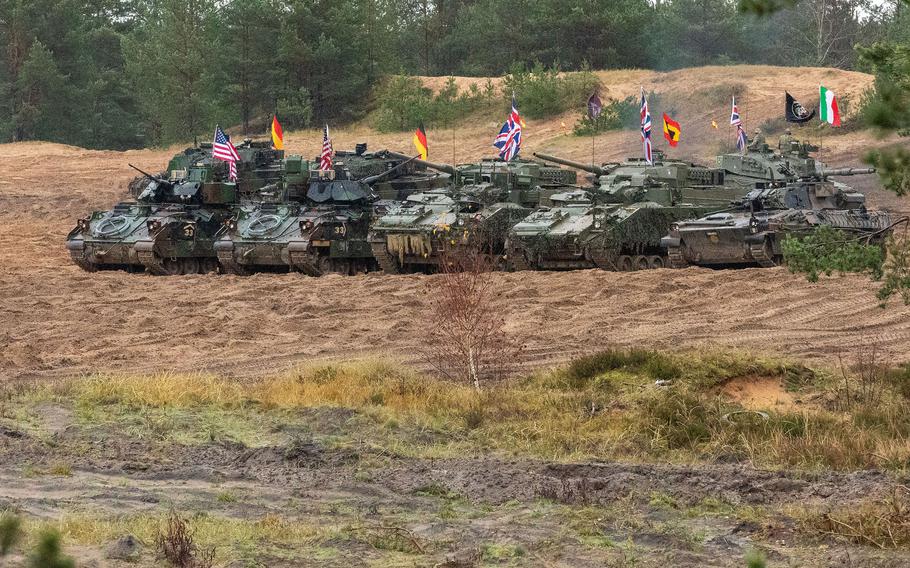
Troops from Germany, Italy, the Netherlands, the U.K. and the U.S., assigned to NATO’s enhanced Forward Presence Battle Group Poland, stage their vehicles before a firepower demonstration in Adazi, Latvia, Nov. 13, 2023. NATO members must focus on how to boost weapons production quickly to win a long war, according to a Rand Corp. study. (U.S. Army)
STUTTGART, Germany — Insufficient ammunition, manpower shortages and questions about the West’s popular support for a potentially long war are the most urgent matters for NATO countries to grapple with as the alliance draws lessons from Russia’s war in Ukraine, a new think tank study says.
Since Russia’s full-scale attack in February 2022, U.S. and other military strategists have been studying the war in detail, looking for tactical insights and advantages that can be gleaned from the largest armed conflict in Europe since World War II.
The war, which has involved trench tactics from the early 20th century, also has been a testing ground for cutting-edge technology ranging from the electromagnetic realm to drones that have reset the battlefield. Army commanders and security analysts have pondered the various tactical implications in scores of military journals.
But the biggest takeaway from the war has nothing to do with tactics, according to the Rand Corp., which conducted the study in coordination with the United Kingdom’s defense ministry.
In fact, there’s no compelling evidence that NATO needs any fundamental change in how it maneuvers on the battlefield or commands missions, Rand said.
The most pressing question is whether sufficient resources are available to credibly implement NATO plans over the course of a long war, the report said.
“Urgent action is needed to address a lack of sufficient mass of personnel, equipment or stockpiles, especially munitions,” Rand said in its report, released Monday. “Shortfalls are also reported in readiness, training and infrastructure and in levels of industrial mobilization and societal resilience more widely.”
One reason it is difficult to draw sweeping tactical lessons from the war is that a conflict between Russia and NATO would look completely different from what’s unfolded in Ukraine, Rand said.
Just as Russia would alter its own approach, the collective power of the U.S.-led NATO alliance would incorporate air and long-range strike capabilities that Ukraine isn’t even close to matching.
NATO countries, which have provided billions in arms to Ukraine, are not without weaknesses, despite the alliance’s collective might. The war has demonstrated “a notable lag” in the buildup of production capacity both in Europe and in the United States, exposing vulnerabilities when it comes to replenishing munitions at the speed they’re expended, the report said.
The U.S. and its Western allies have stepped up production of weapons and ammunition over the past two years, but critics say it isn’t enough.
On Tuesday, the head of the U.S. Indo-Pacific command raised an alarm over the issue, saying that the conflict in Ukraine and unrest in the Middle East are chipping away at an arsenal also needed in the Pacific.
“With some of the Patriots that have been employed, some of the air-to-air missiles that have been employed, it’s now eating into stocks, and to say otherwise would be dishonest,” Adm. Sam Paparo said during a Brookings Institution event in Washington.
U.S. European Command’s Gen. Christopher Cavoli also has repeatedly said ramping up the West’s defense industrial base is paramount.
“The scale of this war is out of proportion with all of our recent thinking,” Cavoli said as far back as January 2023 at a security forum in Sweden. “But it is real and we must contend with it.”
Meanwhile, Russian President Vladimir Putin has put his economy on a wartime footing, demonstrating the ability to ramp up production of munitions and weapons systems to replenish his military’s heavy losses in Ukraine.
In the West, home to liberal democracies with divergent views on security and an industrial base that has been depleted over the years, following suit is likely to be a more complicated endeavor.
But without sufficient resourcing or “underlying political, industrial and societal support to sustain potentially years of warfighting at scale, (NATO) will fight well — for a short while — but then it will be attritted and the war will in all possibility be lost,” Rand said in the report.